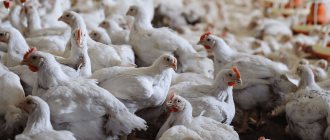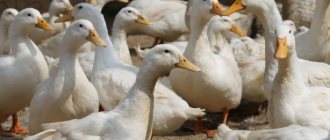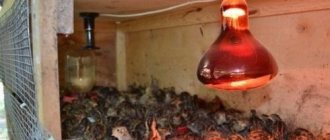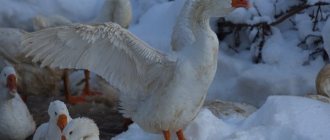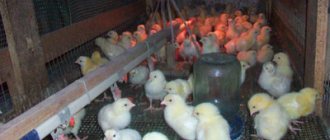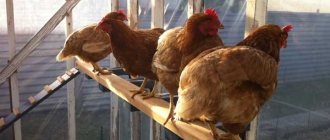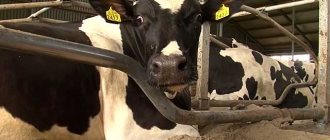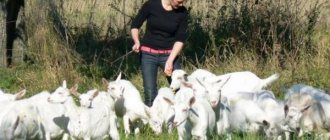Exterior of a bird
High Line birds are not easy to distinguish from other chickens, but they have a certain standard.
The main characteristics of High Line chickens:
- the body is small, narrow, slightly oblong in the shape of a triangle;
- the head is small, the neck is strong;
- the comb is pinkish in color and has pointed teeth;
- earrings are small in the shape of an oval;
- the comb is darker than the skin on the face;
- yellow eyes;
- wings fit tightly to the body, developed;
- the tail is small, fluffy and raised high;
- the plumage is dense, white or brown in color.
History of the origin of the cross
The egg cross was created in 1936 by Hy-Line International, which is located in America. Scientists spent 5 years before achieving their goal - to breed a hybrid characterized by good health, undemanding conditions and high egg productivity.
As a result of selection, 2 types of high-line chickens were created - white and brown. They are similar to each other in terms of production indicators, but differ in plumage color and egg shell color:
- high-line brown - birds with brown feather color, laying eggs with the same shell color;
- high-line white - have snow-white plumage and lay eggs with white shells.
This hybrid is common in America, Brazil, Western Europe, some Asian countries and the Middle East. Russian farmers are also familiar with egg crosses.
Characteristics of High-Line chickens
High-Line individuals are small birds of a thin build; the hen reaches a weight of 1.8 kg, and the rooster does not gain more than 2.5 kg.
Character
High Line individuals will not create trouble for the owner; they have an excellent calm character.
The birds are very quiet and peaceful; they will not provoke other birds into fights and conflicts. They can boast of excellent resistance to stress and are very difficult to get angry. Males are also not bad, they look after the “girls”, protect them, stand up for them, try to help them avoid any dangers.
Representatives of the High Line cross behave like phlegmatic people, they are not particularly interested in the outside world, it seems as if they are constantly thinking about something and solving their personal dilemmas. Birds are interesting to watch. Individuals excellently endure any hardships and trials of life.
Puberty and egg production
Crosses with an average rate of puberty, starting laying at the age of six months.
Often there are no delays. If birds begin to lay eggs later than 6 months, then there is only one reason - an incorrect diet. Overfeeding or underfeeding usually has a negative effect on females; natural processes stop or do not proceed as nature intended.
Hatching instinct
Purebred chicken breeds have maternal instinct; crosses and hybrids have lost it during selection. Cross High Line is no exception; laying hens do not have a brooding instinct, but this is more an advantage than a disadvantage.
The incubation process forces females to incubate offspring for a long time, and therefore laying hens cannot lay eggs during this period. And the results of their egg laying are truly record-breaking.
Keeping Hy-Line chickens is considered profitable because the laying hen can work and not be distracted by the work of the “mother,” which today the poultry farmer can entrust to both another hen and the incubator. Features of incubating chicken eggs are described here. But remember that the offspring of the cross will have noticeably lower levels of egg production, etc., than their parents.
Breed overview
High Line is an egg-laying breed of chickens without significant drawbacks or special comments. The bird is calm by temperament and does not require much care. Laying hens have excellent immunity and high viability - about 96%. All this indicates good profitability when breeding it. In addition, this breed will delight you with its appearance.
Origin
High Line chickens are a cross of American breeding, which was bred by the scientific center of the company of the same name. Among the main objectives of the institute was to obtain an improved breed of birds, which is distinguished by egg production and is absolutely unpretentious in terms of balanced feed and living conditions. This is how the High Line chickens were born.
It should also be noted that breeders managed to achieve an excellent degree of viability, disease resistance, good egg production and a long period of profitability. The eggs that this breed produces are large (weight 60-65 grams) and have a strong shell. As a result of selection, several varieties were obtained: brown and white birds. They all have a similar appearance and productive qualities, differing only slightly in the color of their plumage.
Appearance
High Line chickens are relatively light in weight. By the 4th month, the weight of the bird fluctuates around 1.3-1.5 kg. The chickens are beautiful to look at, slender and have a rather large bright comb. Feather color is brown or white.
The head is small in size, has a strong yellowish beak, a thick neck of medium length, an elongated body and a wide back. The wings are well developed, tightly pressed to the body, the tail is of medium length. All spring indicators indicate good egg production of the bird. The photos below and a brief description of the High Line chicken breed once again prove this.
Productivity
The growth and development characteristics of High Line hens and roosters differ at different age periods. For example, from the first day of life until 4 months, they actively gain weight. Then the growth rate sharply decreases, and the bird takes on its final appearance. Adults at the age of 1.5 years have a mass of about 2.3 kg, while high feed consumption remains. But such costs are compensated by the output of the number of eggs, which can reach from 240 to 340 pieces per year.
The active productive period of the laying hen begins at the age of about 6 months. And the calm nature, high percentage of vitality and excellent immunity that this breed possesses makes it possible to successfully keep birds for mass breeding.
Content Features
The mortality of young animals, as well as the costs of feeding and breeding in an incubator are low. Adult chickens consume feed in a productive ratio of up to 1200 grams per 1 dozen eggs. The average consumption criterion for young animals is 6 kg per day, which is quite favorable compared to many other egg breeds.
There are no special requirements for lighting, humidity level and temperature of keeping High Lines. Maintenance requirements are common, but experts advise maintaining cleanliness in the enclosures where laying hens live. It is also important to feed on time and pay due attention to the quality of the feed. In addition, it is mandatory to get vaccinated against possible infection with dangerous diseases.
Productive qualities
As for their weight gain, it is very slow and small. Adult chickens reach 1.8 kg, and roosters are 0.5 kg more.
Average annual egg production
It’s not for nothing that the High Line cross is considered an egg breed; individuals occupy a leading place in this matter. In 1 year, a female can produce more than 300 eggs; the record was 340 eggs. Everything directly depends on the diet of birds. The weight of one egg varies within 65 g. The shell is white, without spots.
At first, after the start of oviposition, the testicles are small, but after a couple of months they become larger, such eggs can later be used for incubation.
Pros and cons of cross
Hy-Line hybrids have their advantages and disadvantages, they must be taken into account when breeding birds.
Advantages:
- high productivity;
- low maintenance requirements;
- standard diet, without special “dishes”;
- rapid adaptation to a new environment.
Flaws:
- lack of maternal instinct;
- a short period of high egg production, in order to prevent this disadvantage from occurring, you need to think about replacing the livestock in time.
Types of crosses
American scientists have managed to breed several types of Hy-Line hybrids. The key differences are the color of the feathers and the shade of the shell. Brown birds are large in size. Their reproductive period begins 1 week later.
High Line Brown
This breed is characterized by brown tint of feathers and the same eggs. Bird subtypes include Sonya and Silver Brown. Birds are characterized by active growth for 18 weeks. During this time they eat 6-6.7 kilograms of food.
With the onset of puberty, the weight of chickens reaches 1.5-1.6 kilograms. By 74 weeks, the bird grows to 2 kilograms. To increase egg production, chickens need to be given 115 grams of feed per day.
High Line white
These chickens are smaller in size. The first time they lay eggs a week earlier than the brown ones. By 4 months, the birds reach a weight of 1.3 kilograms; at 74 weeks, their weight reaches 1.65-1.75 kilograms. During active development, birds eat 6 kilograms of feed. Subsequently, they should receive 100-105 grams of feed per day. Birds lay 330 eggs per year.
Conditions of detention
The main advantage is that they are unpretentious and can live in any conditions. For comfortable keeping, poultry farmers equip a chicken coop with ventilation. Individuals tolerate low temperatures well, but still the ideal temperature for them is +10...+26 degrees Celsius.
If the winters in the region are too frosty, then you will have to install a heater in the room; in other cases, the chicken coop is insulated, whitewashed and regularly treated.
Chicken coop requirements
To properly keep chickens, it is important to adhere to simple requirements for arranging a chicken coop:
- To prevent the egg production of females from falling, lighting is installed in the room. Daylight hours should be about 14 hours. In summer, south-facing windows help with this, and in winter, additional light. You can purchase and install infrared lamps; they not only illuminate the area, but also give off heat.
- Chickens are kept on warm bedding made from peat, sawdust or straw. It is better to use the first option, since this material gives off heat when in contact with droppings. Even if there is extreme cold in the fresh air, the temperature in the chicken coop will not drop below +10 degrees.
- Nests are required; they are installed in the back of the room, near the far wall. The place should be dark and impenetrable. For 3 females – 1 box. It’s a good idea to place them in a ladder, one above the other. How to build nests on your own is described in this article.
- To spend the night, birds need perches; the usual requirements are the diameter of the beam is 4 cm. The perches are placed at a height of 1 m. Each female needs 0.35 m of perch.
- Containers for water and food are placed on the floor and washed every day.
- It is necessary to monitor the cleanliness of the litter, stir it up and change it from time to time. During the same period, the walls, floor and ceiling are treated.
- Bird droppings contain a small proportion of ammonia, which has a detrimental effect on their respiratory system and housing and communal services. To avoid this, a high-quality ventilation system should be installed.
- The humidity in the room should vary within 65%. When birds walk in the fresh air, you need to open the barn and ventilate it.
How to build a suitable chicken coop yourself is described in detail here.
You don’t have to equip a large yard for walking; it’s enough to make a small enclosure. During the warm season, birds should be outdoors. There must be a large amount of grass in the yard that the birds can chew. Containers with ash are also installed, in which birds bathe and clean their feathers from insects.
Individuals are released into fresh air only at temperatures above -7 degrees Celsius. Long walks in the cold lead to frostbite on the paws and ridges.
Ration High Line
At special poultry farms, laying hens are fed feed with vitamins and minerals, which contain all the components necessary for chickens. On the farm, feeding laying hens is somewhat different, but the diet must be balanced in any case.
On your farm, you can add various additives to your birds’ menu. Another advantage of this cross is the low feed consumption per individual (approximately 100 g of grain per day). And with all this, this norm does not change depending on the time of year and their needs.
Diet of High Line chickens:
- Ground or whole grain. Great options include corn, oats, wheat, rye and barley. In winter, feed your birds grain sprouts as useful mineral supplements.
- Beans: soybeans, lentils and peas.
- Fresh or dried herbs: nettle, alfalfa, dandelions, vegetable tops, plantain.
- Wet mash , including vegetables, cooked in meat or vegetable broth.
- Boiled vegetables: beets, zucchini, pumpkin and cabbage leaves.
Add chalk, egg shells, yeast, bone and meat-and-bone meal to the diet of laying hens. Crosses, especially the egg variety, need a lot of calcium and vitamins.
Maintenance and care
The industrial flock is kept in harsh conditions - the birds never see sunlight and cannot roam freely. An enclosed space with multi-level batteries of cages is a common way of life for winged flocks in poultry farms.
Factory-produced chickens require virtually no human attention or participation - the keeping process is practically automated. Birds receive food strictly according to the clock.
But, at home, if you have the opportunity and desire, you can brighten up the life of hens and create more comfortable conditions for them. Laying hens will be grateful for a small walking yard with a high fence. The poultry house is equipped with multi-level high perches, onto which the winged family can easily climb.
Let's also consider the temperature indicators that are recommended for winged workers. They tolerate cold quite well, but severe frosts can harm quons - in particular, they are fraught with frostbite on the crests. In winter, it is recommended to maintain the air temperature within 10 degrees.
Molting and break in egg production
Chickens moult once a year, and even during this period they lay eggs, although a little more passively than the rest of the time. Molting may not begin, and in this case they resort to stimulation.
In the case of artificial stimulation, molting occurs much faster and is almost painless and without consequences.
Planned herd replacement
It is necessary to raise the young generation to replace laying hens early, taking into account the fact that the productive period ends at the age of one and a half years. Then there is a sharp decrease in egg-laying activity.
Frequent illnesses
The main difficulty in breeding hybrids is the lack of resistance to diseases. In this variety, this problem was solved at the selection stage - the chickens developed strong immunity and the survival rate is about 96-97%.
But standard preventive measures are still necessary. If you purchase livestock from a poultry farm, laying hens should be quarantined and given antibiotics for preventive purposes.
Often the High Line breed of chickens from a poultry farm are carriers of various infections, and they can infect other residents of the chicken coop.
What are the reviews?
Raising chickens
Chicken Raising Basics:
- Chicks at the age of 1 day are placed in a special brooder with a thermostat. A sawdust bedding is placed at the bottom; it must be changed on time. For the first 3 days, babies live in 24-hour lighting.
- In the brooder the temperature is kept at +32 degrees Celsius, every week the temperature is lowered by 2 degrees. Thus, the chicks get used to normal temperatures.
- By observing the young animals, you can determine how they feel. If they are cold, the kids group together and sit closer to the heat source; if it is hot, they drink a lot of water, practically do not eat, and sit far from the lamp.
- Babies are transferred to an adult chicken coop at the age of 40 days. During this period, birds gain feathers and do not need additional warmth. The chicken coop is treated, feeders and drinking bowls are installed in it. How to make a drinking bowl for chickens with your own hands is described here.
- In the first days, the chicks are fed a boiled egg mixed with cereal. Special feed is introduced into the diet, suitable for the composition and age of the birds. Mixtures for young animals up to 2 weeks of age are finely ground.
Similar crosses
In the cities of the Russian Federation, cross-breeding is not particularly popular, so it is difficult to find an official poultry farm in your city. But there is a way out - laying hens can be replaced with other equally productive hybrids:
- Hisex . Ancestors - Leghorn and New Hampshire. Weight is from 1.5 to 2.5 kg, egg production per year is more than 300 pieces, weight of one is 65 g. Puberty begins at 5 months. Balanced and calm disposition.
- Shaver . Egg production - more than 350 eggs per year, strong immunity, endurance and tolerance. Plumage color – white, black. The mass of the individual is from 1.7 to 2 kg.
- Loman Brown. Puberty at 5 months. Egg production is up to 320 pieces per year, the weight of one is 65 g. Good-natured and peace-loving chickens.
- Tetra. They have strong immunity and produce about 250 eggs per year.
Reviews of High-Line chickens
★★★★★
Vera, 46 years old, teacher, Omsk. I have been breeding these hybrids for more than 4 years.
The laying hens are very strong, strong, and did not get sick. They behave appropriately, do not swear, do not fight. They are distinguished by their ease of care and high productivity. I recommend everyone I know to get these chickens. ★★★★★
Sofia, 67 years old, librarian, Sochi. I started high-line chickens in my backyard.
The laying hen family is small, only 12 birds. My husband and I wanted to have unpretentious and productive crosses; the birds lay about 300 eggs a year and do not need special conditions. This cross meets all our requirements. ★★★★★
Oleg, 32 years old, lawyer, Simferopol. The birds were chosen due to their calm disposition, otherwise we had nervous and aggressive breeds at our dacha, and there was no peace from them.
Hy-Line chickens were placed with other poultry, so they got along with them and did not get into fights. They don’t eat much, but they bring eggs like from a machine gun. Hide
Add your review
High Line chickens are one of the most desirable egg breeding birds. Many poultry farmers strive to breed these hybrids on their territory. Reviews from breeders claim that the cross does not have any particular disadvantages, but the list of advantages is impressive.
0
0
Copy link
What to feed chickens
We recommend reading our other articles
- Onion sets - varieties, planting and care
- What not to feed rabbits
- New Zealand white rabbit
- What to feed peppers with?
Hy-Line chickens consume about 110-140 g per day
Hy-Line chickens consume about 110-140 g of feed per individual per day. Feed is given 3 times a day, while in the summer, if the birds walk during the day, you can feed them only 2 times - in the morning and in the evening. Every day, the bird’s diet should contain grains and legumes, vegetables, root vegetables, herbs, and minerals (salt, chalk, premixes). It doesn’t hurt to sometimes feed chickens dairy products, this will increase egg production and egg quality.
To ensure that the hen always produces approximately the same number of high-quality eggs, premixes are added to her diet. It is also important to ensure that these birds always have crushed shells and gravel in a separate bowl.
It is important to equip the chicken coop with a sufficient number of drinkers (preferably nipple ones). The water in them changes as it gets dirty or runs out.
